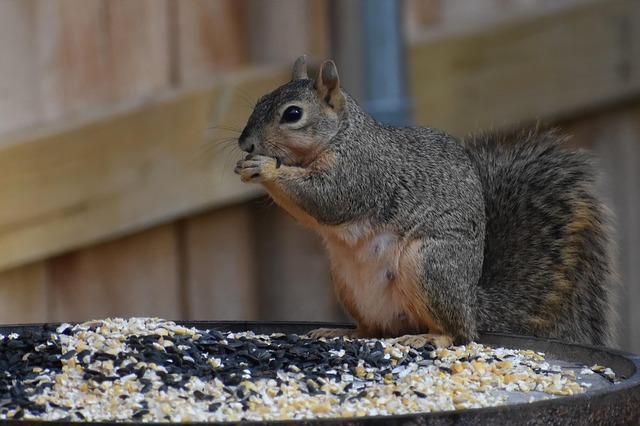Squirrel infestation treatment requires understanding the creatures' behavior and preferred entry points, such as gaps around pipes, vents, doors, and windows. Homeowners should conduct seasonal inspections and seal these access points with materials like steel wool, caulk, or mesh netting to prevent intrusion. Combining physical barriers and strategic sealing techniques, along with regular maintenance, is vital for a successful squirrel infestation treatment that focuses on both prevention and clean environment maintenance.
Squirrel infestation can cause significant damage to structures, from gnawed wiring to chewed insulation. Understanding these clever critters and their habits is crucial in effective squirrel infestation treatment. This article guides you through identifying common entry points, implementing robust sealing techniques, and adopting long-term prevention strategies to keep squirrels at bay. Learn how to protect your home or business from these persistent pests once and for all.
Understanding Squirrel Infestation and Its Impact
Squirrels, while adorable, can become a nuisance when they infiltrate structures, leading to what’s commonly referred to as a squirrel infestation. This issue is more than just an inconvenience; it can cause significant damage to buildings and pose health risks. These rodents are known to chew through wiring, insulation, and even wood, resulting in costly repairs. Moreover, their nests and droppings can trigger allergies and respiratory issues for occupants.
Effective squirrel infestation treatment involves understanding their behavior and habitat. Squires are crepuscular and nocturnal, preferring to be active during dawn and dusk. They enter structures through various entry points, such as gaps around pipes, vents, doors, and windows. To prevent and manage this problem, sealing these access points is crucial, ensuring a secure and squirrel-free environment.
Identifying Entry Points: Common Access Points for Squirrels
Squirrels are adept at finding their way into structures, often through what seem like obscure entry points. Identifying these points is a crucial step in addressing a squirrel infestation treatment plan. Common access points include gaps around pipes and wires entering buildings, cracks in foundations or walls, and openings in roofs or attics. These areas provide convenient routes for squirrels seeking food, shelter, or places to nest.
Homeowners should conduct a thorough inspection of their properties, especially during the fall when squirrels are more active, to pinpoint these entry points. By sealing these access points with appropriate materials like steel wool, caulk, or mesh, you can significantly deter squirrels from gaining unauthorized entry into your home or property.
Effective Sealing Techniques to Deter Squirrels
To effectively seal entry points and prevent squirrels from infiltrating structures, property owners should employ a combination of physical barriers and strategic sealing techniques. Start by conducting a thorough inspection to identify common squirrel access points such as gaps around pipes, wires, doors, and windows. Once identified, these areas should be sealed with durable materials like steel wool, hardware cloth, or caulk. For smaller openings, mesh wiring or fine-gauge metal screens can be used to create an impenetrable barrier without hindering airflow.
Additionally, installing squirrel-proof fixtures and fittings is essential in the squirrel infestation treatment process. This includes using heavy-duty door sweeps on entryways, securing vents with fine mesh screens, and sealing off any attic or roof access points with tight-fitting covers. Regular maintenance and seasonal checks are crucial to ensuring these seals remain effective over time, as squirrels are adept at finding new ways into structures, especially during changing seasons when food resources become scarce.
Long-term Prevention Strategies for Squirrel Infestations
Squirrel infestations can be a persistent problem, requiring long-term strategies for effective squirrel infestation treatment. The key to preventing recurring issues lies in sealing entry points and removing potential food sources. By thoroughly inspecting your structure, you can identify and close any gaps, cracks, or openings that squirrels might use as access points. This includes checking around windows, doors, vents, and rooflines. Using weatherproofing materials like steel wool, caulk, or foam can help fill these spaces, making it difficult for squirrels to gain entry.
Additionally, maintaining a clean environment is crucial. Ensuring no food debris or sources of water are accessible outside your home will deter squirrels from considering it as a meal spot or nesting area. Regularly trimming trees and shrubs away from the structure also helps reduce hiding spots and access points. These combined efforts can significantly decrease the likelihood of future squirrel infestations, providing long-lasting protection for your property.
Sealing entry points is a proactive approach to prevent and treat squirrel infestations. By understanding common access points and employing effective sealing techniques, homeowners can deter squirrels from entering their structures. Combining these methods with long-term prevention strategies ensures a squirrel-free environment. For those dealing with existing infestations, addressing these issues promptly is crucial for minimizing damage and maintaining a healthy living space.
